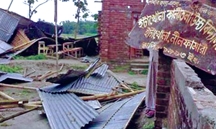Nor’wester
Nor'wester (Kal-Baishakhi) thunderstorm that generally blows over Bangladesh usually in April-May from a northwesterly direction, locally known as Kal-baishakhi. Nor'wester thunderstorm coincides with the setting in of the summer season. It grows when the atmosphere becomes sufficiently unstable because of localised surface heating or other causes. Air that becomes buoyant rises and is cooled by adiabatic expansion until it eventually reaches saturation point and causes a cumulus cloud. If the atmosphere is unstable further, the cumulus cloud grows vertically to form cumulonimbus cloud and subsequently a thunderstorm, popularly known as nor'wester. The difference between an ordinary shower and this type of storm is that it is always associated with thunder and lightning. It is like a thermodynamic machine in which the latent heat of condensation is rapidly converted into the kinetic energy of ascending air currents.

From mid-March to April the temperature in Bangladesh rises sharply compared to the preceding months (ie winter months). In the middle of April the whole country, especially the northwestern part, records a sharp rise in day temperature. Presence of warm and moist air in the lower layer of the atmosphere is an essential precondition for the development of a nor'wester. Unstable atmosphere and intense convective activity are other important factors for their origin and growth. Nor'westers may be called air mass thunderstorms or convective thunderstorms, since they frequently occur in warm air masses and in the summer.
The main reasons behind the nor'wester is the warm and moist air coming from the southeast which rises up to 2 kilometres, mixes with the relatively cold and dry jet streams coming from the northwesterly and westerly directions. The mixing of these two dissimilar air masses causes storms. The warm and moist air rises due to the Chotanagpur Plateau, Himalayan ranges, and Assam Plateau. The life cycle of a nor'wester is associated with (1) cumulus; (2) mature; and (3) dissipating stages which are determined by the magnitude and direction of the ascending or descending air currents. After 30 to 45 minutes the mature nor'wester begins to decrease in intensity and enters the dissipating stage. Because of very steep temperature lapse rate, high water content of clouds and the cumulous updrafts, hail is common to a nor'wester. The size of a hail is determined by the rate of uplift within a cloud and its high water content. Thunder and lightning is common with a nor'wester. Nor'westers are more frequent in the late afternoon because of the influence of surface heating in producing convection currents in the atmosphere. In the western region of Bangladesh, nor'westers come in the late afternoon and before evening but in the eastern side it comes generally after evening, moving from a northwesterly to a easterly and southeasterly direction. In this season the morning remains calm. Temperature begins to rise from noon creating a convective current and the storm is formed. The average wind speed of a nor'wester is 40-60 km per hour. But in exceptional circumstances the wind speed may exceed 100 km. The duration of the storm is generally less than an hour but sometimes it may exceed an hour. [Mesbah-us-Saleheen]
